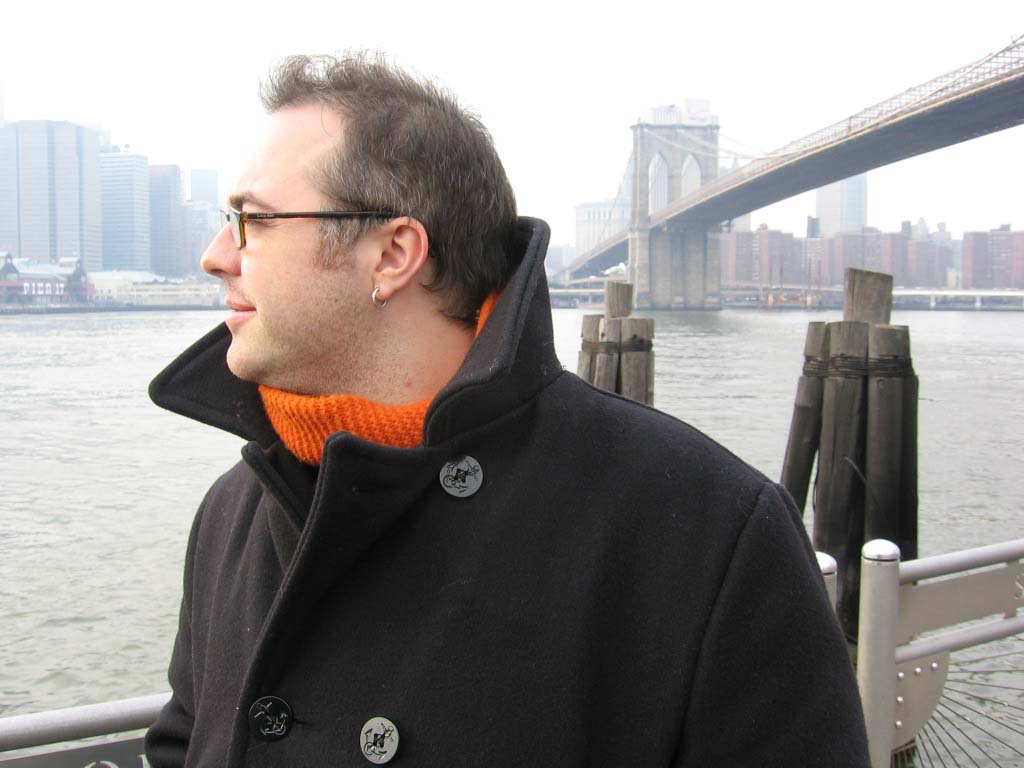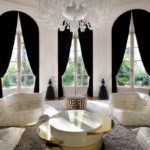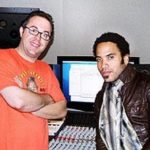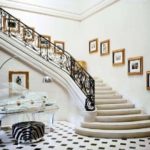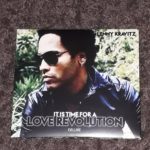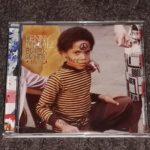I have not had the opportunity to say it before but Lenny Kravitz is one of my favorite artists, and I was eager to express it here, especially since I was really taken by the song « Dream » released on his « Black & White America » album. Here is a conversation I had with Cyrille Taillandier, the sound engineer who recorded that mystical song, in order to learn more about it. A big « thank you » to him!
First, how did you develop a passion for sound engineering and eventually started a career?
When I was a kid, I was always interested in technology – first, by space technology and airplanes. So I was thinking about how to build airplanes, jets, helicopters and all kinds of stuff. I was also interested in scuba-diving so as my parents said, I was either in space or underwater, not really on Earth.
My parents have always loved music and we listened to a lot of music all the time. We had a couple of instruments at home – guitars, organs, keyboards… and eventually I discovered that there was technology involved in the recording of music. My brother had some albums and at the time on vinyl records you had big pictures, not like on CDs, and I think I saw pictures of recording studios on some of those albums. I got intrigued and I started playing a bit with synthesizers and drum machines, and programming some music with friends. I was lucky that I found a studio in the south of Paris, Chauve-Souris, and I called them up out of the blue to see if I could sit in on sessions, and they said : « Yes ». The guy just told me : « Sit in the corner and don’t say anything. If people need help moving something, help them. You can help make coffee or something. »
So that’s really how I got started – I was able to witness recording sessions and I really loved the process of people recording and mixing, and all that. That’s how I decided to try to pursue that thing. At the same time that I got a little Yamaha four-track cassette, I started demo recording at home. I turned a closet into a vocal booth and I worked with a couple of bands but not that many at the time. I remember recording heavy metal music and trying to record drums with just one microphone – it was not that easy!
Then I went to school for audio engineering in Paris at a place called ESRA (Ecole Supérieure de Réalisation Audiovisuelle) and the great thing that happened there is that you had to do internship. I knew that I wanted to be in a big recording studio, so I started looking early and I was able to have a lot of choices at the time in Paris – it was around 1991, 1992 maybe. I found an internship at Studio Davout, a big recording studio with three SSL (Solid State Logic) rooms and it was great because once again, I got to be part of recording right away and see how big recording studios worked. I was also very lucky because they hired freelance assistant engineers so I stayed in touch while finishing my degree and the day after I graduated I was working in the studio as an assistant engineer. Since we were freelance we could work for other studios too, which usually was not the case, but this is how I got to work for four different studios in France. They all had SSL consoles and I also got to work on the new SSL 9000 J at the time. I started working with many French artists and also international artists which was the great thing because we had British and American engineers coming to the sessions. Since my level of English was pretty good, they put me on those sessions and I got to work with great people!
You are considered an expert in Pro Tools – can you explain how this software works and its importance?
Pro Tools is a digital audio workstation. When I started people used to call it a direct to disc, which means that instead of recording directly to a tape machine, you can record directly to a hard drive. The big advantage of using a system like Pro Tools is that it’s also what’s called a non-destructive editing system which means that when you’re editing audio, when you’re cutting stuff and moving things around, you’re not destroying any of the original material like you would have to do on tape. Original tape editing literally means cutting the tape and then splicing it back together with scotch tape basically and hoping that the edit sounds good! Now with digital audio you can do that in the computer without erasing anything and with a precision that’s much easier to achieve than what you could do with tape. Also, because you have a visual feedback, you have a drawing of the audio waveform that helps you identify portions of the sound where you want to do your edit.
I started using Pro Tools at Davout a long time ago – I think it was a version 3 or 4, now I guess it’s version 12. You know, I got in the music industry when the shift was happening to use more and more digital workstations so when I started using Pro Tools, it was still something that you would have to rent extra for specific edits because we worked on tape. Some people started to specialize in being Pro Tools engineers and having their own Pro Tools system that they could bring to the studio. I really got more into using Pro Tools when I moved to New York and I worked with Tony Maserati who is one of the best mix engineers in the world in my opinion. I got very lucky to work with him and I was his mixing assistant which means that I would manage the Pro Tools sessions, I would do any edits that we needed to do and set up the mix for him, and also do the recalls as we used to do at the time. I got to work at the best mixing studios in New York with him.
I still use Pro Tools daily and that’s still my preferred digital audio workstation system to work on.
You said you had the opportunity to work with French and international artists very early in your career. How did that happen?
I started my career as an assistant engineer in Paris and then in the south of France, and the great thing about the studios I worked at there was that they usually catered to more international artists than the ones in Paris because of the nice weather in the south of France! So I also got to work with international producers and engineers and that’s how I started to have a more international mix of people I worked with.
There are two reasons why I moved to the United States. First, I worked with some American engineers in Paris and I really liked the way they worked – the style, the way they behave, the way they made things sound… So I was very intrigued and I got to meet a couple of producers that I became friends with so I had connections in New York, just by being their assistant. I stayed in touch over the years and then, working on a record with a French band from Toulouse called Zebda, I got a chance to work in the south of France and also travel to New York for the finishing of their record called « Essence Ordinaire ». I wasn’t hired at the time to work on the finishing of the record but I just took a vacation time to go to New York and hang out basically with them and their producer, Nick Sansano. And I really loved New York! I really enjoyed the city and the studio so I thought that maybe I could try to move to New York, and that’s what I did about a year after that, around 1998-1999.
Another thing that pushed me to move to New York was the fact that when I was working at Davout, the Rolling Stones came in for a few sessions but I was not hired to be the assistant. Even though I had been doing all the international sessions for two years at Davout without ever any problems, when the Rolling Stones came around, they asked an advanced engineer to work as an assistant on those sessions. Consequently, I felt limited there in my career and I thought : « Well, maybe there’s nowhere to go for me here so maybe I should go to New York and see what I can do. » Because I really loved the music anyway, I loved the people and the city, so that’s what I did – I moved to New York! And I was very, very lucky that I had kept in touch with those producers and engineers that I had worked with in France because they really helped me there – finding a place to stay, finding a job and things like that. That’s the lesson or something you would hear that most people talk about – it has a lot to do with connections. You never know what a job or meeting certain people is going to lead to, but that’s really what happened for me. I took a chance in a way to move to New York and see what was going to happen. I was lucky that I was single and didn’t have kids or a family to have to make that decision – I was free to go! Then I got my job with Tony Maserati through another engineer called Rich Travali who I worked with on the Passi album called « LesTentations ». Since I moved to New York and lived in Brooklyn I got to work with a lot more American artists, of course.
Your first collaboration with Lenny Kravitz was on the « Baptism » album in 2004 as the assistant engineer of Henry Hirsch. How did that team reach you?
The way I ended up working with Lenny Kravitz is once again through the connection I had with Rich Travali. This guy is the reason why we are talking today because he gave me the chance! I was his assistant on the mixing for Passi and we had a great time. When I moved to New York, he’s the one who introduced me to Tony Maserati who was looking for a mix assistant and a guy who knew Pro Tools, and that’s how I got the job! While I was starting to freelance more when I was working with Tony, Rich called me and hooked me up with Henry Hirsch who was working with Lenny Kravitz. Henry was looking for a second engineer who also knew Pro Tools really well and Rich recommended me. The first time I met Henry Hirsch was at the Edison Studio that doesn’t exist anymore – it was inside the Edison Hotel in Time Square. Basically he interviewed me and showed me their set up, and a few days later we took time to do a test session. He wanted to test my knowledge of Pro Tools and of a recording studio, to see if I could start working with him and Lenny. I passed the test and we started working together on that record. I ended up working on three records with Lenny and engineering more and more. The reason why is because for some of those sessions, Henry didn’t really want to travel to certain places where we did some sessions – Los Angeles, Miami, Paris, of course… I was more ready to travel and go to sessions anywhere.
And I think Lenny became comfortable working with me. Working with him has been some of the best years of my life and some of the best experience of my engineering career! Because of the music he makes which I really enjoy. Because of his amazing talents as a musician, a singer and a producer. And also because of the equipment I got to use with Henry and Lenny – they really like vintage equipment, but also equipment that really gives you great results. I was very lucky once again to work with great equipment, with great musicians like Craig Ross who’s been playing guitar with Lenny for a long time. I learned a lot from them, with them. For a few years before that I was working every day with Tony Maserati so I got a great education for my ears, a great training that really helped working Lenny afterwards. Over the years, it was a great relationship because it’s a high caliber of talent and musicianship and high pressure. I also got to work with other artists that Lenny produced or worked with and to be in the same studio with Jay-Z, Lionel Richie… With Henry we also worked on some other projects, for instance with Rob Thomas from the band Matchbox 20 or Steven Tyler from Aerosmith – it was great! The thing that I try to tell my students now that I teach is that the work you do with musicians is the same whether they are international superstars or people from your neighborhood. You don’t necessarily realize that when you’re doing it but after a few years you start to realize that you have to treat everybody with respect and you can have a great time with people as long as you all share the same passion for music and good sounds.
Craig Ross, for instance, is a great guy. He’s very laid back and nice. It was pretty incredible for me to be with those guys in the studio because I would be sitting a few feet from them and I just watched them play and listened to them create a song. Another fun experience was the Superbowl as we had to record the backing track because everybody has to record a safety playback track for the Superbowl. So we got to record the medley of « Are You Gonna Go My Way » and I got to watch those two guys sitting next to me in the control room playing those riffs that I’ve heard since I was a kid. At that time you pinch yourself, you think you’re dreaming and you can’t believe your luck! It’s happening right there and it sounds like the record you’ve heard for so many years. Magical moments! That’s the dream part of the job as a producer or an engineer. You get the goosebumps while witnessing the magic that those people create. When it’s a new album you get to hear it before anybody else and sometimes you know it’s going to be a hit song. A lot of the time you don’t know but sometimes you can feel it and you keep those memories forever!
The « Black & White America » album is excellent, in my opinion, and the song « Dream » in particular. Can you tell us about the making and the recording of that song, please?
Well, the song « Dream » was not originally recorded for the album. I was living in Ithaca, New York with my wife and one day I got a call from Lenny asking me if I could come to Paris for a couple of days to record a song for a movie. It was supposed to be for a movie soundtrack. I was available so they sent me a plane ticket, my wife drove me to the little Ithaca airport, I took a plane to Philadelphia and then to Paris. Lenny had bought a house in Paris, a « hôtel particulier » (or private mansion) near an embassy, I don’t remember which one. He didn’t have a studio set up really yet, so I brought a laptop, a little audio interface, we also had a couple of microphones and we started with the piano. Lenny had a piano in the staircase of that « hôtel particulier » – maybe it’s a Kawai piano and its particularity is that it’s a transparent piano, in Plexiglas, I think. So we were in that house with a marble staircase and I took advantage of that by placing two microphones near the piano and two microphones upstairs to capture the ambiance. This way there was no artificial reverberation – it was all real reverberation from the house itself. I also had very special microphones preamps by a company called Millennia. The microphones on the piano were Neumann U67s and the ambiance ones were two Neumann, KM 84. What happened then is that Lenny wanted to overdub the vocals, put some bass and some other elements, and at the time the software I was using on the laptop computer that I had brought was Logic 7 or 8. But I was struggling with Logic in creating more tracks which is crazy. I couldn’t figure it out because I was a Pro Tools guy. But you couldn’t run ProTools on a laptop then, so we ended up having to rent a studio to go finish the song.
Fortunately, a friend of mine had a studio just outside Paris called Audiolane with Pro Tools and all kinds of nice stuff. We borrowed a 1960s Fender Precision Bass from a musician called Slim Pezin, a pretty famous French guitar player and we went to the studio. We worked all night and there’s a picture of us that was taken by Bruce (Cherbit), I think, in the morning before we left the studio and we all looked pretty tired because we spent the whole night making the song there. I remember I called my friend Jacques Obadia – who is an great engineer and a voice over talent – to assist me on the session. He very nicely agreed to do that so we did a session together, just Jacques, Lenny and I, and we recorded the bass and the vocals. We got pretty lucky because Lenny owns a very good Neumann U47 microphone that he usually records his vocals with that we didn’t have with us but Bruce, the owner of the studio had just gotten a « clone », a copy of that microphone so we used it and it sounded really great. We also did some synthesizers strings recordings that night with the software we had in the studio, I can’t say which one it was. And that was kind of it!
Then, he presented the song to the director of the movie but they didn’t choose that song. So a few weeks later, when we got to work on the record – which was actually the « (It Is Time for a) Love Revolution » album – we redid the strings arrangement in Paris in Lenny’s house for the song « Dream ». The house has a big living-room and that’s where the strings players were for the recording, so I used the staircase again for reverberation. I re-amped the strings to some very nice Bang & Olufsen speakers that Lenny had and then I captured the ambiance in the staircase to add to the strings. That’s what gives them that kind of ambiance. It was all mixed in the box, as people call it today, that is inside Pro Tools and that’s what ended up on the record. Lenny and Henry have been working for years now in a manner that’s very interesting which is that they work with what people call now « stereo-stems» of instruments which are basically pre-mixes of instruments. People tend to do that now during mixing but they can also do it during recording and that’s similar to the way we did the song. You try to really shape the sound of every instrument the way they’re going to appear in your mix, and you can build it up that way until you’re done with the last overdub.
It was a great song to get to record and I’m sure Lenny was disappointed that it wasn’t chosen for that movie. But he ended up keeping and using it for that album.
That song really has something special, with an atmosphere both intimate and mystical. What kind of instructions did you have in order to reach that result, technically speaking?
Well, I’m not sure that Lenny gave me instructions per say. We really built it up that night after we did the song at his house. But, yes, I think the intimacy of the playing comes from the fact that it was recorded in a house with a grand staircase. Lenny did maybe two or three takes of the piano, without singing, just playing the piano, and that’s what we built the song upon. I guess it is also because the process was pretty intimate, once again – there was nobody else but Lenny, Jacques and me in the studio. It was just us going along and recording the bass and the pads, and Lenny doing his own things on vocals and background vocals too.
There was not a big section of strings so there might have been three people doubling their parts and they worked with Lenny live meaning it was not written. So that’s something that was also pretty immediate and intimate. They came up together with the string lines and they just played them. Once again, the strings were also recorded in the same house so the acoustics were imprinted on the record.
I’m wondering if I even used the reverb on the voice from that staircase – I’m not a 100% sure that I didn’t use a plug-in or something. So yes, I think the way it was recorded helped getting that intimacy.
It is easy to imagine that song being played at the end of concerts, just the piano playing and the voice. Could you feel that potential emotion while recording or did you keep focused on the technical aspect?
The way we recorded it was really starting with the piano so for me it was more technical concentration at first, making sure that I captured the sound the best way I could. But we did actually play with the ambiance so I did take time to install those microphones in the staircase. We liked to react to what we heard, we liked the way the piano sounded in that staircase and that was really a big imprint on the sound of the song.
Then I guess the emotion was more on the vocal part. It was recorded pretty late at night or very early in the morning, it depends on how you look at it. Lenny is a great singer so that really helps, and it is not very loud singing on that song so it was a lot about the vibrato and the breath. I don’t remember that we did a lot of takes, either. I don’t think I have the session anymore and I wish I had, but I don’t remember any struggle singing it. It was more about getting a nice sound.
But the emotion was also with the piano. You could feel the goosebumps too…
Where do you put your collaboration with Lenny Kravitz in your career?
At the top!!
What about your musical activity nowadays?
My musical activity has been greatly reduced because I’m teaching full time so I do much less sessions but I’ve been doing more mixing. I’m working with a band that’s kind of a mix of funk and hip-hop so I’m doing some mixes on that at my home studio. I’ve also been lucky to keep in touch with Angélique Kidjo, a great singer, and I did a few sessions with her and her husband and producer, Jean Hebrail, over the years in the USA and in Paris. It’s been a couple of years though that I didn’t get to mix any of her songs so I hope to work with them again on that. I’ve always had a dream of recording Angélique and Lenny together.
I teach at Drexel University and I am leading a community recording project, creating workshops and a studio for people in the neighborhood to come record and mix their songs, poems or stories. So I’ve been pretty busy with that and since I also have a family with young kids, I’ve been traveling less for work and more for family.
